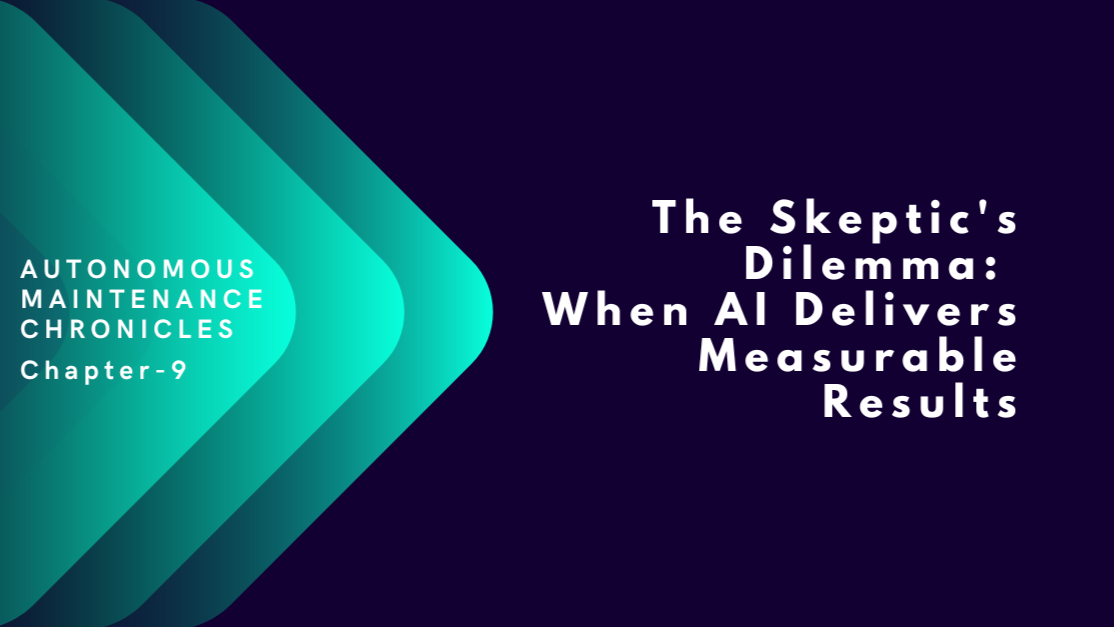
Published on :
Beyond the AI Hype: Real Evidence for Maintenance TransformationHow Asset Condition Intelligence is Delivering Measurable Results Where Traditional Approaches Fail
“AI will revolutionize maintenance.” We’ve all heard it. We’ve also seen the disappointment when new tools delivered little more than expensive dashboards. The real question isn’t can AI help—it’s whether it can deliver measurable value in the real world.
Evidence is now emerging, and it’s reshaping not just how we look at maintenance—but how we define Autonomous Maintenance itself.
A facility’s air handling unit appeared healthy: airflow steady, temperature under control, no alarms. Traditional maintenance would mark it as fine. AI told a different story:
👉 AI Assessment: Condition C1 (Deep Repair Required), 75% confidence
👉 Impact: ~336 kWh wasted daily = $15,000–30,000 annually per unit
The unit was “working”—but silently failing, burning money, and racing toward breakdown.
In earlier editions of the Chronicles, we framed Autonomous Maintenance as reducing human dependency up until the wrench is lifted. Over time, our learnings have expanded:
The evolution is clear: from detection → orchestration → measurable transformation.
“AI can’t handle complexity.” AI correlated pressure, fan speed, thermal hunting, and energy waste—patterns no human could process simultaneously.
“AI lacks technician intuition.” AI doesn’t replace intuition—it scales it. What takes hours of troubleshooting emerges instantly from cross-asset pattern recognition.
“Energy claims are simplistic.” AI quantifies specifics:
This isn’t theory—it’s a business case.
ROI (conservative):
AI uncovers recurring patterns that traditional methods miss:
This shifts maintenance from symptom-chasing to root-cause resolution—a key milestone on our Autonomous Maintenance journey.
AI helps match skill level to task:
👉 Senior techs spend less time on data hunting, more on solving complex problems.
For Service Companies:
For Facility Owners:
The AHU case proves it: AI spotted what humans missed, quantified the impact, and prescribed fixes. This isn’t hype—it’s operational reality.
What started as an experiment in automating maintenance activities is now maturing into an Autonomous Operations Center that delivers measurable ROI, scales expertise, and builds resilience across entire portfolios.
The question isn’t whether AI and Autonomous Maintenance can transform operations. The question is: can you afford to keep operating without them?
🔎 What’s your take? Are you still skeptical about AI in maintenance—or seeing it become a foundation for the future of operations?
#AutonomousMaintenance #FMInnovation #AIinFM #FacilitiesManagement #OperationalIntelligence
Lorem ipsum dolor sit amet, consectetur adipiscing elit, sed do eiusmod tempor incididunt ut labore et dolore magna aliqua. Ut enim ad minim veniam, quis nostrud exercitation ullamco laboris nisi ut aliquip ex ea commodo consequat. Duis aute irure dolor in reprehenderit in voluptate velit esse cillum dolore eu fugiat nulla pariatur.
Block quote
Ordered list
Unordered list
Bold text
Emphasis
Superscript
Subscript
© Xempla. All rights reserved.